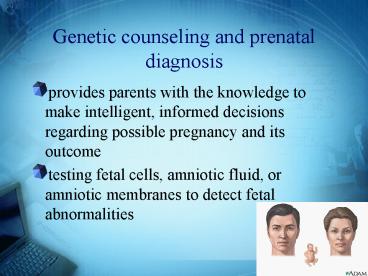Genetic counseling and prenatal diagnosis - PowerPoint PPT Presentation
1 / 20
Title:
Genetic counseling and prenatal diagnosis
Description:
nutritional counseling. psycho-social status. Preconceptional Counseling ... comprehend the medical facts, including the diagnosis, the probable course of ... – PowerPoint PPT presentation
Number of Views:673
Avg rating:3.0/5.0
Title: Genetic counseling and prenatal diagnosis
1
Genetic counseling and prenatal diagnosis
- provides parents with the knowledge to make
intelligent, informed decisions regarding
possible pregnancy and its outcome - testing fetal cells, amniotic fluid, or amniotic
membranes to detect fetal abnormalities
2
Preconceptional counseling
- Many women were now postponing pregnancy and
limiting family size, while at the same time
striving to optimize the outcome of each
pregnancy. - The focus of obstetrical care has changed once
again, from treating maternal and fetal disease
to predicting and preventing them.
3
Timing of counseling
- before conception or marriage provide
opportunities for carrier detection, prenatal
diagnosis or the presentation of other important
options - The optimal time to initiate counseling is
therefore not during pregnancy.
4
Preconceptional Counseling
- maternal disease
- diabetes mellitus
- cardiac disease, other medical diseases,
medications - sexually transmitted diseases
- any previous poor pregnancy outcome
- habitual abortion, ectopic pregnancy, infertility
- immunizations
- genetic risks
- nutritional counseling
- psycho-social status
5
Preconceptional Counseling
- congenital anomalies
- general incidence
- major anomalies 2 - 3 live born infants at term
- leading cause of infant mortality
- minor anomalies 7 - 10
- high risk
- family history
- previous pregnancy with congenital disease
- advanced maternal age
6
Purpose
- comprehend the medical facts, including the
diagnosis, the probable course of the disorder,
and the available management - understand the way heredity contributes to the
disorder and the risk recurrence for themselves
and family members
7
Purpose
- understand the options for dealing with the risk
of recurrence - identify those values, beliefs, goals, and
relationships affected by the risk for or
presence of hereditary diseasec - choose the course of action that seems most
appropriate to them in view of their risk, their
family goals, and their ethical and religious
standards
8
Purpose
- make the best possible adjustment to the disorder
or to the risk of recurrence of that disorder, or
both, by providing supportive counseling to
families and making referrals to appropriate
support services or groups, or both
9
Methods of prenatal diagnosis
- invasive test
- amniocentesis
- chorionic villus sampling
- cordocentesis
- preimplantation genectic diagnosis
10
Methods of prenatal diagnosis
- noninvasive test
- maternal serum screening
- ultrasonography
- isolation fetal cells or DNA from maternal
circulation
11
(No Transcript)
12
(No Transcript)
13
Preimplantation genetic diagnosis
- utilizing access to gametes or embryos before 6
days, the time at which implantation occurs - polar body biopsy
- aspiration of one to two cells from the six to
eight-cell embryo at 2 to 3 days - trophectoderm biopsy of the 5- to 6-day blastocyst
14
Preimplantation genetic diagnosis
- aspirating 1 - 2 of the 6 - 8 cells contained
within the zona pellucida - Removal of 1 or 2 cells did not affect glucose or
pyruvate uptake or delay spontaneous hatching of
blastocysts, the traditional indicator of normal
embryonic development.
15
Fetal cells in maternal circulation
- nested primer PCR for Y-specific DNA
- fetal trophoblasts, lymphocytes, granulocytes,
and nucleated red blood cells (NRBCs) - rarity of fetal cells in maternal blood (1107)
- detection rate for aneuploidy 40-59
16
Fetal cells in maternal circulation
17
Fetal cells in maternal circulation
18
Preimplantation genetic diagnosis
19
(No Transcript)
20
Chromosome X (green)Chromosome Y (orange)
21
FISH
- hybridized to uncultured amniocyte
- three aqua signals
- 3 copies of chromosome 18
22
Spectral karyotyping (SKY)
23
Spectral karyotyping (SKY)

